There’s nothing quite as satisfying as pulling up to your favourite summertime holiday destination with your caravan or camper, getting all set up and settling down in the camp chair with a nice, cold drink from your fridge. But for many travellers, the refrigerator in their RV is a constant source of frustration. It’s either never cold enough, or it freezes everything! Either way, the result is the same: spoilt food or no cold drinks.
In this yarn about how to keep your fridge cool in summer, we want to talk about caravan fridges and how you can get the best out of them. RV Daily sat down with Mike Silich from Everything Caravans, who services RV fridges every day, and got his top tips for ensuring your fridge keeps its cool in summer.
Fridge types explained
There are two main types of caravan fridges: the compressor and three-way absorption fridges. Compressor fridges work pretty much the same as your fridge at home, except it uses a 12-volt power source rather than 240V mains. For the most part, they are pretty reliable and don’t cause their owner’s too much trouble. However, they do tend to draw a lot of power and, when free camping, they require decent battery capacity and lots of solar to keep up with their power needs.
Three-way fridges can operate on either 240-volt mains, 12-volt or gas. Their design dates back to the early 1900s, and they do a remarkably good job at keeping our food and drinks cold. When free-camping and operating on gas, they are incredibly efficient. However, they can be problematic and are prone to subtle changes in their environment such as ambient temperatures and how level the ground you’re parked on is.
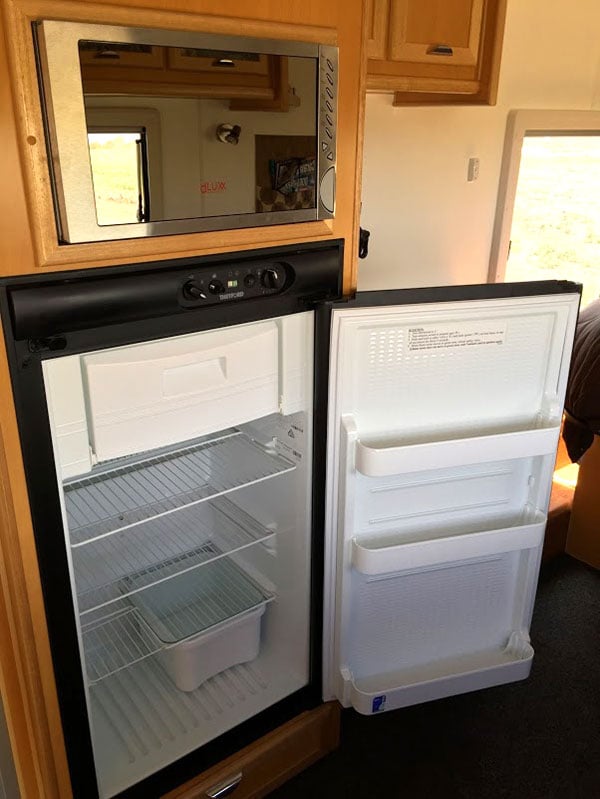
Ventilation is vital
All fridges work on the principle of removing heat from the storage area and transferring it outside, away from the fridge. Thus, the refrigerator needs good ventilation. Compressor fridges in caravans usually have a fan that moves air through their condenser, so ventilation is not so critical. But three-way fridges rely heavily on the chimney effect to achieve efficient cooling. For this reason, the way the manufacturer installs the fridge is absolutely critical.
Some owners fit fans to increase the airflow across the condenser to get better cooling, but according to Mike, this may not always be a solution.
“We generally only fit them to overcome poor ventilation. What we are trying to achieve is maximum airflow over the top fins of the cooling fins and out of the top fridge vent. Just fitting a fan is not a guarantee of better fridge performance. If it were that simple, all fridge manufacturers would have fitted them already. The best thing to do is to improve the installation to achieve a chimney effect. The easier we make it for a fridge to remove the heat, the better it will run.”
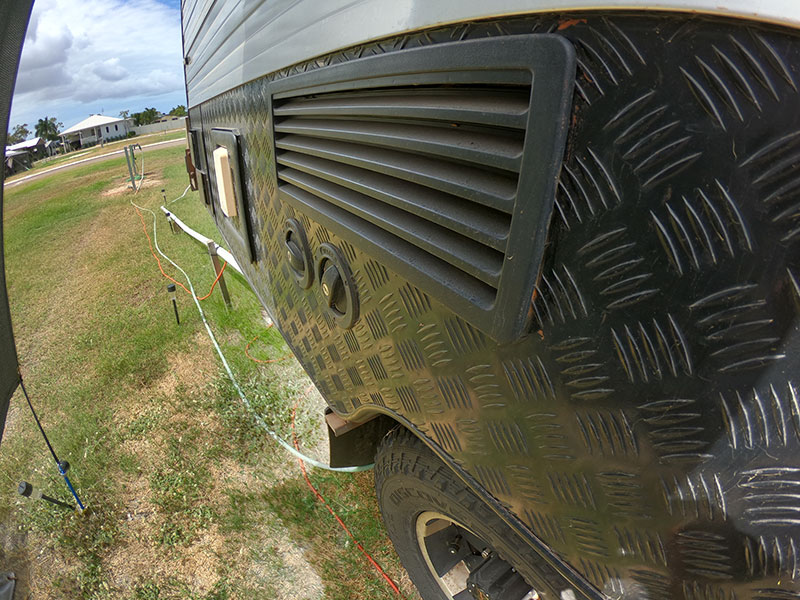
Stay on the level
Unlike compressor fridges, three-way caravan fridges need to be level to operate correctly. Even if they are out of level by just a few degrees, they may not work at all, particularly in hot weather. Mike explains, “If the fridge is out of level, the gas floating by convection and the liquids moving by gravity will struggle to get themselves to the right spots in the cooling unit and, in turn, can’t create the cold you want.
“With levelling generally, in ambient temperatures of 30 degrees C or below, if the van is level enough for sleeping, then it is most likely good enough for the fridge. But when the temperature rises above 30 degrees C, we need to keep the fridge at a level as high as possible. A spirit level on the drawbar may not be accurate enough. Place a spirit level in the freezer box and level the van to this (the bubble must not be touching any of the lines).
“Take the spirit level out and find a place that matches the freezer and is a bit more accessible, such as a benchtop, doorway, or even the “A” frame of the van. Then always level the trailer to this spot.”
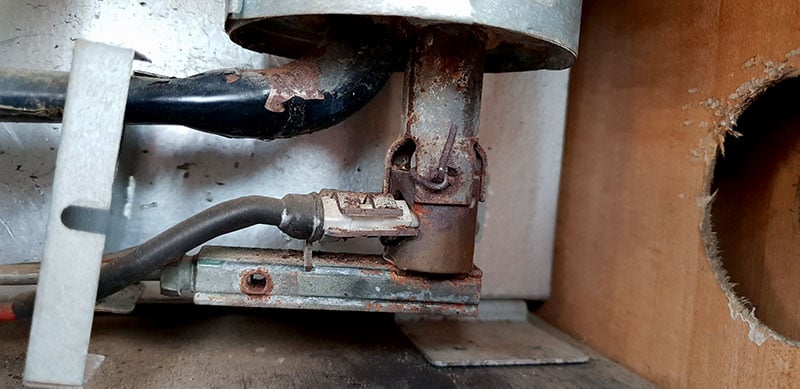
It’s all in the packing
How you pack your caravan fridge is just as important as anything else when it comes to keeping everything cold. Unfortunately, there are a few schools of thought on how best to pack a fridge. For a start, you want to ensure there is sufficient space between items in the refrigerator to allow cooling air to chill everything evenly. On the other hand, packing items close together increases the thermal mass inside the fridge. Think of it this way. A single big ice cube takes longer to melt than a lot of little ones, but it also takes a lot more time and energy to create.
By packing items of different sizes and shapes together, you create sufficient space between them to ensure air can circulate without losing too much thermal mass.
Another good tip is to turn your fridge on and allow it to cool down before packing it. Mike explains, “A compressor fridge can cool down quite quickly, but a three-way fridge can take four to eight hours to cool down”.
He recommends turning the fridge on at least one night before travel. If you turn it on a few days before you’re due to leave on your trip, you’ll have a chance to make sure it’s working correctly and, if it’s not, get it fixed in time for your holiday.
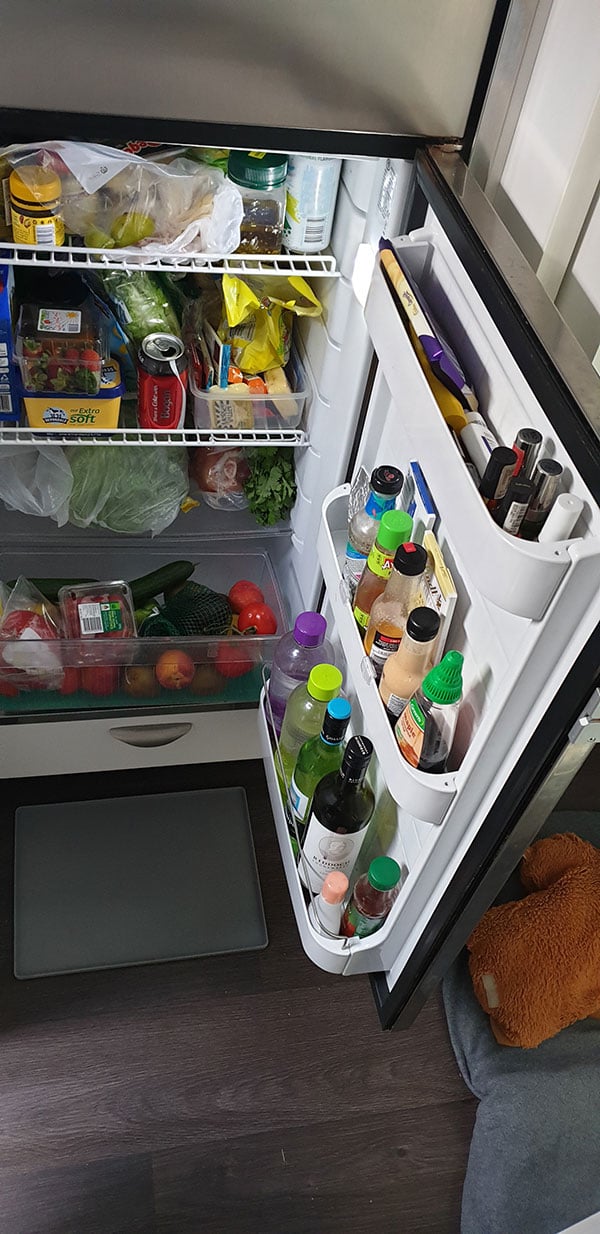
Avoid direct sunlight
When positioning your RV, it is essential to avoid sunlight falling onto the side where your caravan fridge is situated. If the fridge side of your RV is facing north, the sun will shine on it all day. Face it east or west, and you’ll only have the sun on it for half a day. Face south, and your fridge will remain in the shade for the entire day.
Admittedly, it’s not always possible to choose which way your RV faces, so a lot of owners install a small shade sail to block any direct sunlight from falling onto the fridge. These work well. We have one for our fridge and find it very effective.
However, Mike warns that some fridge shades can have the opposite effect. He said, “The best thing to do is allow as much airflow up and out of the fridge vents – some installations I have seen of shade cloths hinder the airflow.”
If you’re going to install a shade on the fridge side of your van, make sure it is spaced far enough away from the van so that air can still flow through the vents.
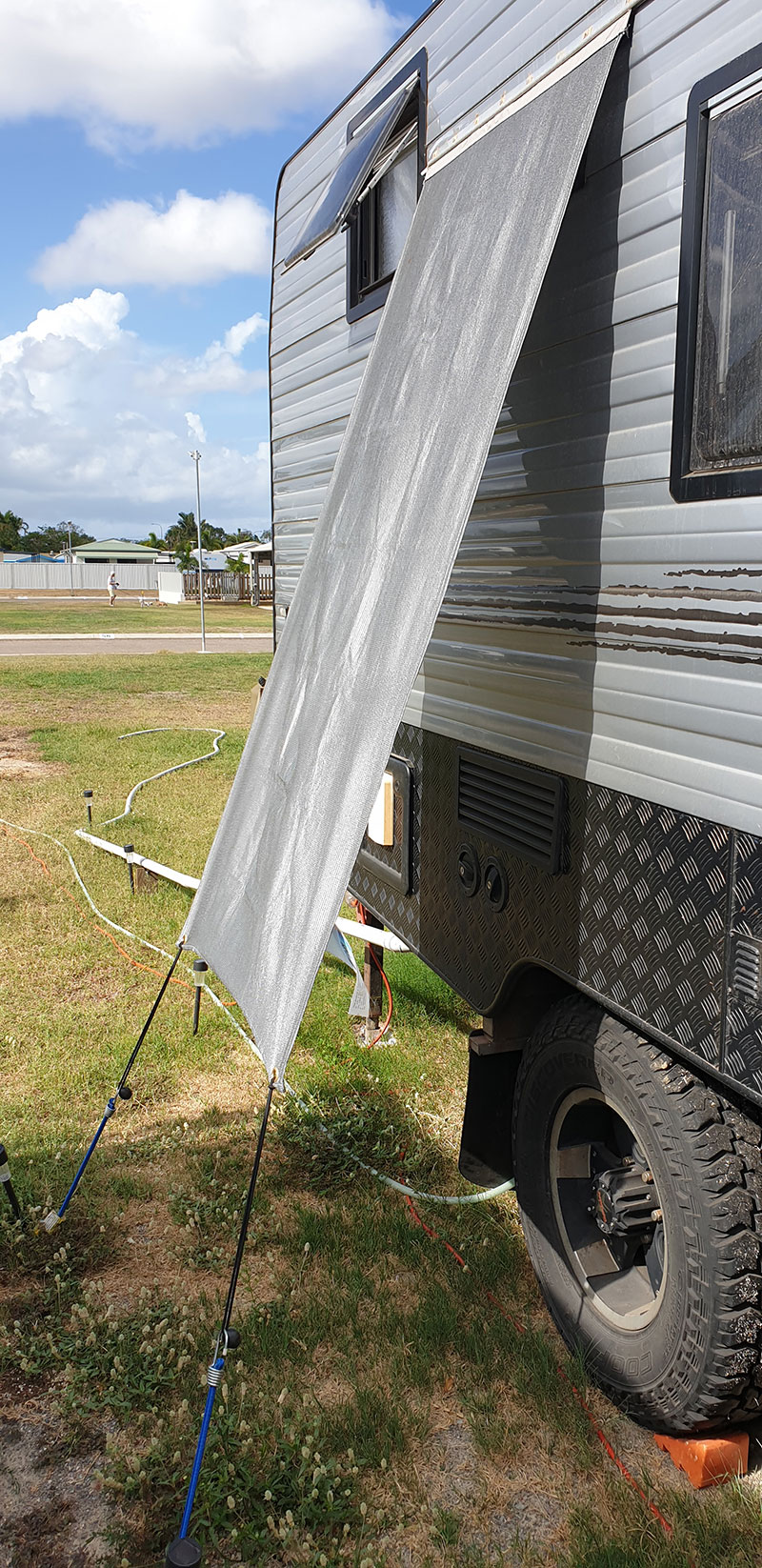
The importance of adequate wiring
Any appliance that runs from 12 volts will require cabling of sufficient diameter to cope with its specific current draw. Think of electricity like water running through a pipe. The bigger the pipe, the more water can flow through it. Compressor fridges draw anywhere up to seven amps when the compressor is running, and this will require reasonable quality cabling.
A three-way caravan fridge will draw around 14 amps when operating on 12 volts. That’s a massive amount of current that will require good cabling indeed. What’s more, almost all three-way fridges draw their power from the tow vehicle’s alternator when operating on 12 volts.
As Mike explains, “Most van and vehicle wiring is more than likely not as heavy as it should be and will suffer voltage drop.”
If you’re finding it difficult to keep your fridge running on 12 volts, inadequate wiring is likely to be the cause, and you should get it checked out by a specialised fridge repairer.
Monitoring the fridge with a thermometer
And finally, in our yarn on how to keep your caravan fridge cool in summer, many owners concerned about the performance of their refrigerators will fit a digital thermometer and track its temperature fluctuations. Mike has reservations about this practice.
“I think these cause a lot of unnecessary concern for some people as fridge temperatures fluctuate a lot in use. No household fridge has a digital temperature gauge in the door and for a good reason. Most people would be shocked to see the temperature fluctuations, especially after loading the fridge with stock and during defrost cycles. What we are aiming for in a fridge is an average temp of four degrees C in a fridge compartment and, for deep freezing, approximately -16 degrees C. A few degrees up or down at different times of the day should not be an issue.”
As you can see, there’s a lot more to running an RV fridge than a standard household fridge. They are designed to operate with a variety of power sources, they have to work in varied environments, and they need to withstand the rigours of mobile operation. All of these factors conspire against their ability to keep the contents cold.
Still, by understanding how they work and adopting a few simple tips, we can arrive at our summer holiday destination safe in the knowledge our food and drinks inside the caravan fridge are cold and ready.
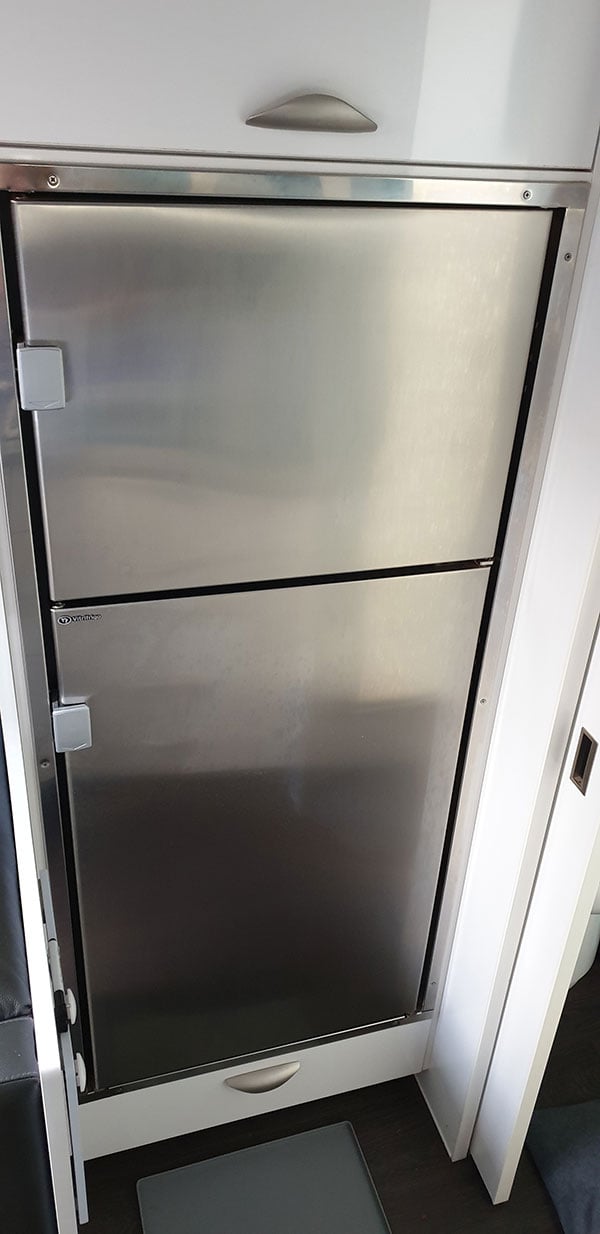
Our hot tips to keep your fridge cool in summer!
Hot tip 1:
Reducing the number of times you have to open the fridge lessens the amount of work it has to do to keep the contents cold. Using a small compressor fridge to store food and drink that you need constant access to minimise the strain on the main fridge. Small car fridges can cope much better with being opened more often as their compressors only have to cool a small compartment.
Hot tip 2:
Check the door seals to ensure the fridge is closing correctly. If you can easily pass a piece of paper between the closed door and the seal into the refrigerator, you need to get it checked by a specialised fridge repairer.
Hot tip 3:
If you’re using your RV fridge continuously or for extended periods in humid weather, you need to check for frosting and icing up. RV fridges do not automatically defrost themselves. When the refrigerator is low on contents, take the opportunity to defrost it by placing any remaining items into insulated shopping bags, turn off the fridge, and place a large bowl of hot water into the middle shelf. Any formed ice will quickly start to melt and fall away.
Hot tip 4:
Do not be tempted to run your three-way fridge on gas while mobile. This is an extremely dangerous practice. If you were to pull into a petrol station while the gas flame is burning, you would be an ignition source for any fumes or leaking fuel.
Hot tip 5:
Have your three-way fridge regularly serviced, especially if you haven’t used it for a few months. The gas jet that feeds the burner is prone to becoming clogged with dirt, carbon or even insect nests. If the jet is partially blocked, it will not burn the gas cleanly, causing soot build-up or, worse, a fire.
Hot tip 6:
Whenever possible, pack a fridge with items that are already cold. If you have to load it with warm items, do so at night to minimise the load on the fridge.
Read next:


